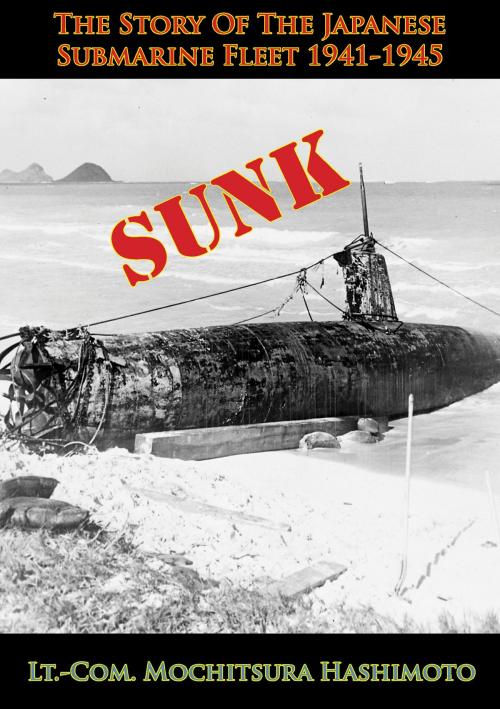Sunk: The Story Of The Japanese Submarine Fleet 1941-1945
Nonfiction, History, Germany, European General, Military, United States| Author: | Lt.-Com. Mochitsura Hashimoto | ISBN: | 9781786257307 |
| Publisher: | Verdun Press | Publication: | November 6, 2015 |
| Imprint: | Verdun Press | Language: | English |
| Author: | Lt.-Com. Mochitsura Hashimoto |
| ISBN: | 9781786257307 |
| Publisher: | Verdun Press |
| Publication: | November 6, 2015 |
| Imprint: | Verdun Press |
| Language: | English |
What happened to Japan’s submarines and what sort of fight did they put up?
As far as Japan was concerned, the recent war was waged according to a rigid strategy. There was no detailed operational planning. It was a fight in which science had been ignored. In such circumstances the submarine, always highly vulnerable unless used intelligently, was inevitably sacrificed. Throughout the war the whole submarine fleet was in reality a special attack force in which, in the absence of scientific weapons, the crews were just so much human ammunition. Today we hear much about rearmament. If money is to be spent on armaments, it should be used for scientific development. Never again must we go to war with only a bamboo lance.
The Japanese Submarine Fleet was entirely wiped out, but the martial spirits of its sailors are still with us on the far-flung oceans. In the Pacific, the Indian Ocean, and the Atlantic we remember the multitude of resentful sleeping warriors; in our ears we hear the whisper of the “voice from the bottom of the sea.”
Thus, as one of the few submarine captains to survive, I have taken up my pen to try to record something of the unknown hardships and successes of our submarines.
“Despite the gloomy conditions under which they worked, our submarines fought well, and the grim story of Japanese submarine units has been well recorded by former Lieutenant Commander Hashimoto.
“It is certainly valuable material, and I wish to recommend it as an excellent history.”—S. Toyoda, Former C.-in-C., Combined Fleet, IJN
What happened to Japan’s submarines and what sort of fight did they put up?
As far as Japan was concerned, the recent war was waged according to a rigid strategy. There was no detailed operational planning. It was a fight in which science had been ignored. In such circumstances the submarine, always highly vulnerable unless used intelligently, was inevitably sacrificed. Throughout the war the whole submarine fleet was in reality a special attack force in which, in the absence of scientific weapons, the crews were just so much human ammunition. Today we hear much about rearmament. If money is to be spent on armaments, it should be used for scientific development. Never again must we go to war with only a bamboo lance.
The Japanese Submarine Fleet was entirely wiped out, but the martial spirits of its sailors are still with us on the far-flung oceans. In the Pacific, the Indian Ocean, and the Atlantic we remember the multitude of resentful sleeping warriors; in our ears we hear the whisper of the “voice from the bottom of the sea.”
Thus, as one of the few submarine captains to survive, I have taken up my pen to try to record something of the unknown hardships and successes of our submarines.
“Despite the gloomy conditions under which they worked, our submarines fought well, and the grim story of Japanese submarine units has been well recorded by former Lieutenant Commander Hashimoto.
“It is certainly valuable material, and I wish to recommend it as an excellent history.”—S. Toyoda, Former C.-in-C., Combined Fleet, IJN




![Cover of the book NEW ZEALAND DIVISION 1916-1919. The New Zealanders In France [Illustrated Edition] by Lt.-Com. Mochitsura Hashimoto](https://www.kuoky.com/images/2014/june/300x300/9781782892427-VkWo_300x.jpg)


![Cover of the book The Fifth Army In March 1918 [Illustrated Edition] by Lt.-Com. Mochitsura Hashimoto](https://www.kuoky.com/images/2014/august/300x300/9781782894834-9qa1_300x.jpg)
![Cover of the book Give Us This Day [Illustrated Edition] by Lt.-Com. Mochitsura Hashimoto](https://www.kuoky.com/images/2015/november/300x300/9781786251534-2xIN_300x.jpg)



![Cover of the book Conversations With A Stuka Pilot [Illustrated Edition] by Lt.-Com. Mochitsura Hashimoto](https://www.kuoky.com/images/2014/august/300x300/9781782898450-BiYs_300x.jpg)
![Cover of the book Marines In World War II - Bougainville And The Northern Solomons [Illustrated Edition] by Lt.-Com. Mochitsura Hashimoto](https://www.kuoky.com/images/2014/august/300x300/9781782892786-VZXx_300x.jpg)
![Cover of the book PAPUAN CAMPAIGN - The Buna-Sanananda Operation - 16 November 1942 - 23 January 1943 [Illustrated Edition] by Lt.-Com. Mochitsura Hashimoto](https://www.kuoky.com/images/2014/august/300x300/9781782894476-lhVI_300x.jpg)
![Cover of the book Earl Kitchener Of Khartoum: The Story Of His Life [Illustrated Edition] by Lt.-Com. Mochitsura Hashimoto](https://www.kuoky.com/images/2015/november/300x300/9781786251572-Wrdz_300x.jpg)